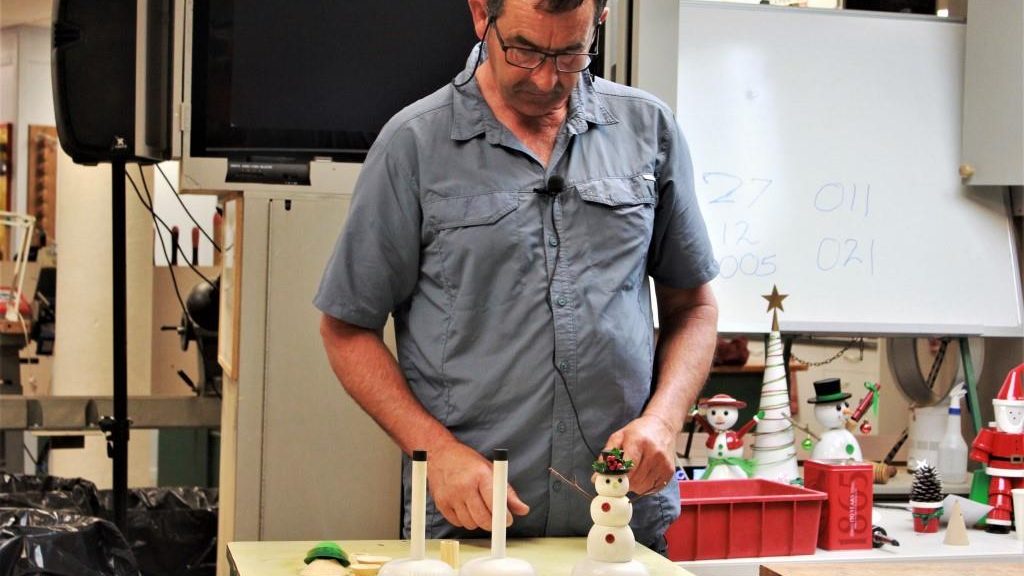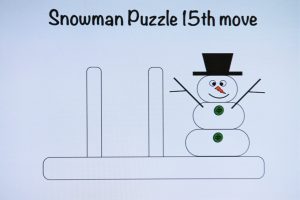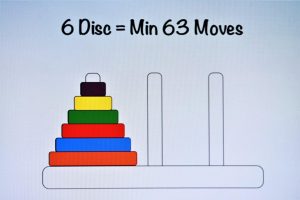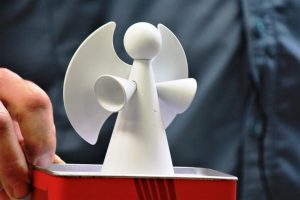Club meeting; 7 November 2018
Report by: Graeme Mackay
A traditional Christmas theme: David produced a good procession of completed snowman and a snow lady. Of course there was a tree. However, in a typical engineering fashion, all were made of small bits joined together to make the whole piece. Each piece was turned then joined together through an excellent demonstration of construction and deconstruction. The Christmas cracker itself came in bits- that is before the cracker explosion. Drawings and embellishment was completed in this case by laser work. Also, David produced a smaller version of the cracker with a bang strip held in place by little PIIGS.
Christmas game: David produced are not an old peg game based on the Tower of Hanoi, an old traditional game. A game explanation was shown on screen. This made it easy to see how the pieces move long the tree peg stands. David reminded people that all these operations can be done using all sorts would including scraps and even bits of pallets. For this demonstration, the base was made of Baltic pine pallet wood. The turning system revolves around a fixed spigot and that had a protruding Dowling. Pieces are rotated on the Dowling to allow finishing to top and bottom. Plumbers tape is used as a gap filler when the fit is not that tight. David mentioned that the number of pieces means that there are more moves to complete
Tip: remember to use hardwood for the fixed bigot. It avoids wear and tear.
Garden pot example: David had a really fun idea of putting the small flowerpots together to make a flowerpot man and/or woman with standard colours using normal house paints. The idea is a work in progress. However, the little project brings up a new view to wood turning
Christmas Angel: The angel, like all Dave’s current ideas, as worked on a fixed spigot with the ability to do both and bottom on the same spigot. The key to this particular Christmas piece is taken advantage of the fixed bigot. David recesses the basin to allow the piece to sit flat down on the period base and give a better view of things.
Tip: use a round mandrel with the centre hole taken out. This avoids sanding in one place and is a useful tool to work on a sphere. Noting, the concept are similar to that using a pipe hand on a wooden sphere for cleaning up.
Another tip: the spigot and a chuck is reusable. Just remember to use hardwood and keep all the pieces holes the same size throughout the project. The plumbers tape allow some accommodation of width differences.
Christmas Angel Arms: David reckons the best look is arms facing downward and the shoulders facing inwards. Misconfiguration gives a better look and is easily accommodated using the index on the lathe. Remember, that the key thing is working on a lathe. Many of these jobs can be done off the lathe. However, in reality the use of the lathe as a good thinking advantage; Wood turning techniques versus woodworking techniques.
The making of armholes of the Christmas Angel is a similar wood turning experience. A wooden chuck based jig is used to hold the body of the angel. The body is held in place with hot melt glue. The Jacobs chuck sitting in the tail rest is used for making holes. Next, the hole can be tapered to get better effect of the angel’s arms.
Tip: using chalk to mark where the current lathe based features are being worked on. Allows for a better view.
Tip: use tape on the lathe bed to make sure the ladies banjos our used in the same way. This allows for a well-placed and even second arm hole.
Tip: with offset turning, remember to leave to speed up as the work is spinning quite at the centre of the piece. And with humour, David commented that one should remember keep hands and arms free and away from spinning piece.
Angel wings: these are formed through the use of a small shallow bowl. The piece can be turned on standard manner, on the mandrel, or even use of Coles jaw. The cutting of the recesses of the wing can be achieved by hand, a bobbin on the lathe, offset turning with a hot melt glue holding or even a large sending board mounted on a lathe. The angles for the arms body and wings is all a matter of choice
Go enjoy yourself
Graeme Mackay



